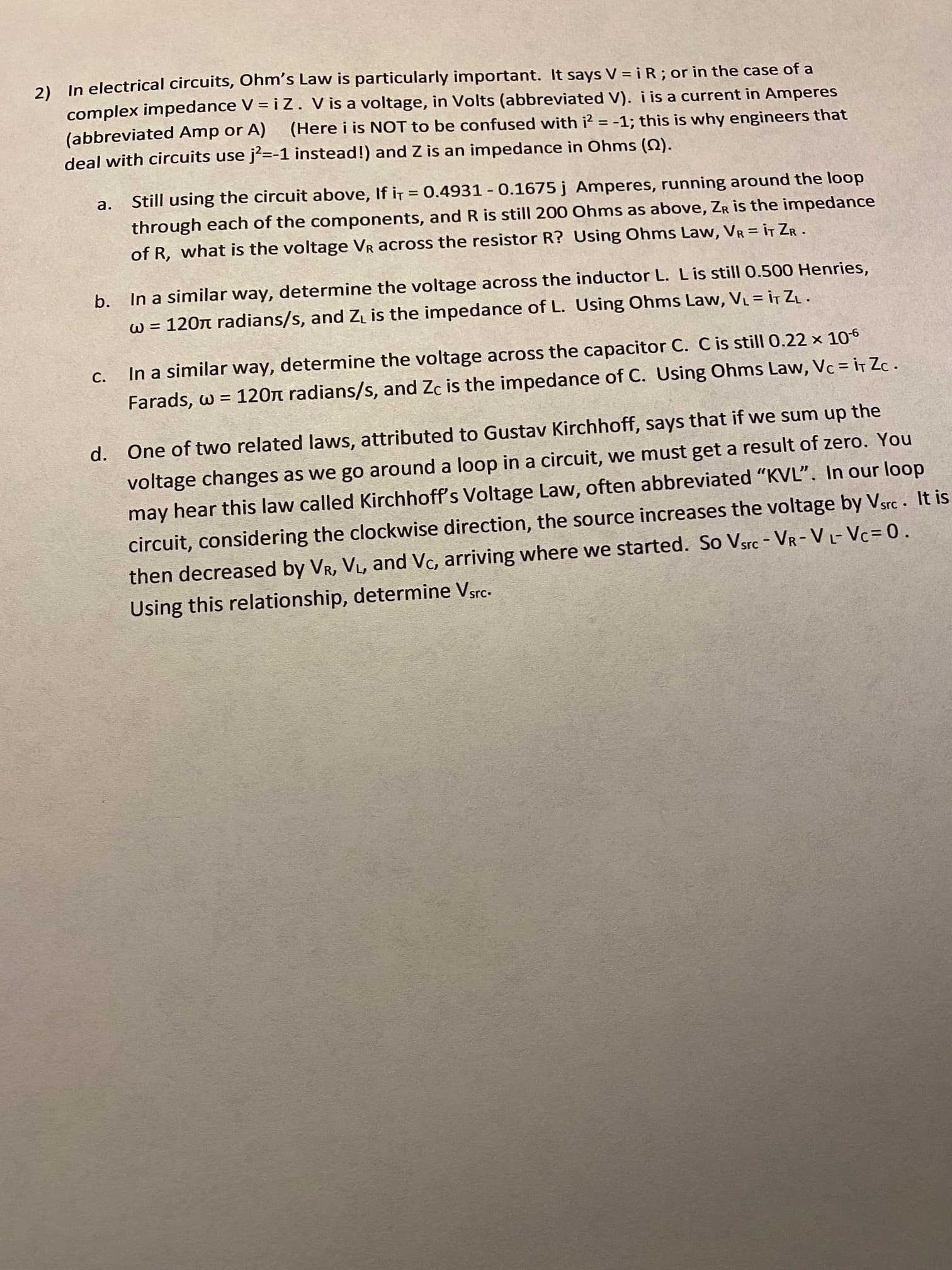а. Still using the circuit above, If it = 0.4931 - 0.1675 j Amperes, running around the loop through each of the components, and R is still 200 Ohms as above, Zr is the impedance of R, what is the voltage VR across the resistor R? Using Ohms Law, VR = iT ZR . b. In a similar way, determine the voltage across the inductor L. Lis still 0.500 Henries, w = 120n radians/s, and ZL is the impedance of L. Using Ohms Law, VL = iT ZL . с. In a similar way, determine the voltage across the capacitor C. C is still 0.22 x 106 Farads, w = 120n radians/s, and Zc is the impedance of C. Using Ohms Law, Vc = iT Zc. d. One of two related laws, attributed to Gustav Kirchhoff, says that if we sum up the voltage changes as we go around a loop in a circuit, we must get a result of zero. You may hear this law called Kirchhoff's Voltage Law, often abbreviated "KVL". In our loop circuit, considering the clockwise direction, the source increases the voltage by Vsrc . It is then decreased by VR, VL, and Vc, arriving where we started. So Vsrc - VR- V L- Vc = 0 . dotermine Vsrc.
а. Still using the circuit above, If it = 0.4931 - 0.1675 j Amperes, running around the loop through each of the components, and R is still 200 Ohms as above, Zr is the impedance of R, what is the voltage VR across the resistor R? Using Ohms Law, VR = iT ZR . b. In a similar way, determine the voltage across the inductor L. Lis still 0.500 Henries, w = 120n radians/s, and ZL is the impedance of L. Using Ohms Law, VL = iT ZL . с. In a similar way, determine the voltage across the capacitor C. C is still 0.22 x 106 Farads, w = 120n radians/s, and Zc is the impedance of C. Using Ohms Law, Vc = iT Zc. d. One of two related laws, attributed to Gustav Kirchhoff, says that if we sum up the voltage changes as we go around a loop in a circuit, we must get a result of zero. You may hear this law called Kirchhoff's Voltage Law, often abbreviated "KVL". In our loop circuit, considering the clockwise direction, the source increases the voltage by Vsrc . It is then decreased by VR, VL, and Vc, arriving where we started. So Vsrc - VR- V L- Vc = 0 . dotermine Vsrc.
Power System Analysis and Design (MindTap Course List)
6th Edition
ISBN:9781305632134
Author:J. Duncan Glover, Thomas Overbye, Mulukutla S. Sarma
Publisher:J. Duncan Glover, Thomas Overbye, Mulukutla S. Sarma
Chapter2: Fundamentals
Section: Chapter Questions
Problem 2.18P: Let a series RLC network be connected to a source voltage V, drawing a current I. (a) In terms of...
Related questions
Question
See attached P2

Transcribed Image Text:а.
Still using the circuit above, If it = 0.4931 - 0.1675 j Amperes, running around the loop
through each of the components, and R is still 200 Ohms as above, Zr is the impedance
of R, what is the voltage VR across the resistor R? Using Ohms Law, VR = iT ZR .
b. In a similar way, determine the voltage across the inductor L. Lis still 0.500 Henries,
w = 120n radians/s, and ZL is the impedance of L. Using Ohms Law, VL = iT ZL .
с.
In a similar way, determine the voltage across the capacitor C. C is still 0.22 x 106
Farads, w =
120n radians/s, and Zc is the impedance of C. Using Ohms Law, Vc = iT Zc.
d. One of two related laws, attributed to Gustav Kirchhoff, says that if we sum up the
voltage changes as we go around a loop in a circuit, we must get a result of zero. You
may hear this law called Kirchhoff's Voltage Law, often abbreviated "KVL". In our loop
circuit, considering the clockwise direction, the source increases the voltage by Vsrc . It is
then decreased by VR, VL, and Vc, arriving where we started. So Vsrc - VR- V L- Vc = 0 .
dotermine Vsrc.
Expert Solution
This question has been solved!
Explore an expertly crafted, step-by-step solution for a thorough understanding of key concepts.
Step by step
Solved in 2 steps with 2 images

Recommended textbooks for you

Power System Analysis and Design (MindTap Course …
Electrical Engineering
ISBN:
9781305632134
Author:
J. Duncan Glover, Thomas Overbye, Mulukutla S. Sarma
Publisher:
Cengage Learning

Power System Analysis and Design (MindTap Course …
Electrical Engineering
ISBN:
9781305632134
Author:
J. Duncan Glover, Thomas Overbye, Mulukutla S. Sarma
Publisher:
Cengage Learning